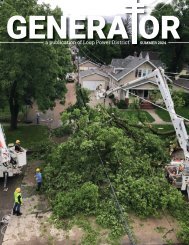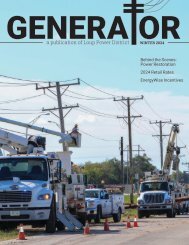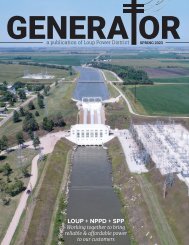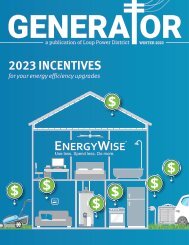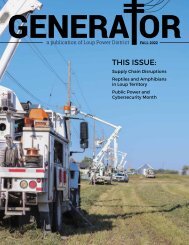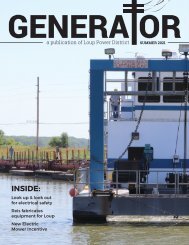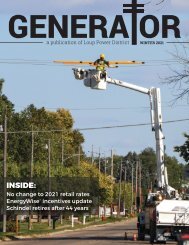Generator Spring 2021
In this edition: new trail at Lake Babcock, three generations of dredgers, tree trimming benefits, employee news and more.
In this edition: new trail at Lake Babcock, three generations of dredgers, tree trimming benefits, employee news and more.
Create successful ePaper yourself
Turn your PDF publications into a flip-book with our unique Google optimized e-Paper software.
GENERA OR<br />
a publication of Loup Power District SPRING <strong>2021</strong><br />
INSIDE:<br />
New trail at Lake Babcock<br />
Three generations of dredgers<br />
Tree trimming benefits
BOARD OF DIRECTORS<br />
Ross Knott<br />
Chairman<br />
Alan Drozd<br />
First Vice Chairman<br />
Steve Heesacker<br />
Second Vice Chairman<br />
Robert Cerv<br />
Secretary<br />
Dick Tooley<br />
Treasurer<br />
Rich Aerni<br />
Jim Donoghue<br />
Mike Fleming<br />
Chris Langemeier<br />
Larry Zach<br />
EXECUTIVE STAFF<br />
Neal Suess<br />
President/CEO<br />
Walt Williams<br />
Vice President,<br />
Accounting & Finance/CFO<br />
Todd Duren<br />
Vice President,<br />
Corporate Services<br />
Korey Hobza<br />
Vice President, Engineering<br />
Dan Hellbusch<br />
Vice President, Operations<br />
The Loup <strong>Generator</strong> is<br />
published quarterly<br />
as a service for Loup<br />
employees, families,<br />
friends and associates.<br />
For feedback, story ideas<br />
and submissions, contact:<br />
Stacy Wemhoff<br />
Communications Coordinator<br />
402-562-5711<br />
swemhoff@loup.com<br />
SHOPPING FOR A NEW LIVING SPACE?<br />
Add energy effi ciency to your checklist<br />
If you’re looking for a new place to live, you likely<br />
have a number of “boxes” you’d like to check, such<br />
as the number of bedrooms and bathrooms, how<br />
much storage space is available, certainly the cost<br />
of your rent or mortgage, taxes, and perhaps a yard<br />
or close proximity to public transportation—all<br />
important.<br />
But what about the estimated cost of your<br />
future energy bills? The annual energy<br />
bill for a typical single family home<br />
is $2,060, so factoring in energy<br />
efficiency aspects as you prepare<br />
to move can help you make<br />
informed decisions to meet<br />
your energy needs. Beyond<br />
the standard walk-through<br />
and home inspection report,<br />
a home energy audit will give<br />
you a more complete and credible<br />
picture of a home’s energy<br />
use. Below are a few important<br />
aspects of your future home’s<br />
energy use to take into account.<br />
Factoring in energy efficiency<br />
aspects can help you make informed decisions<br />
to meet your energy needs.<br />
APPLIANCES<br />
Appliance use makes up a significant<br />
portion of your electric bill. Replacing<br />
older appliances with ENERGY STAR-rated<br />
appliances is a choice that could be more<br />
expensive at first, but could reduce your<br />
annual energy costs.<br />
If a refrigerator is from 2000 or earlier, a new<br />
ENERGY STAR certified model will cost more<br />
upfront but may use just half the electricity. When<br />
comparing new refrigerators, ENERGY STARcertified<br />
models are about 9 percent more energy<br />
efficient than non-certified models, though they<br />
tend to have a higher sticker price. ENERGY STARcertified<br />
dishwashers are 12 percent more efficient<br />
than non-certified models.<br />
WINDOWS<br />
Windows can be a major draw. Look at that view!<br />
They can also be a major energy waster. Feel that<br />
d r a ft ! Old or inefficient windows can let cold air<br />
encroach in winter and conditioned air escape in<br />
summer. Windows strongly influence the effectiveness<br />
of your home’s most basic energy services —<br />
heating, cooling, lighting, and ventilation — which<br />
together account for about two-fifths of a building’s<br />
energy use.<br />
When shopping for a living space, look for<br />
double-paned windows with “low-e” coatings. And<br />
check for weatherstripping, which helps seal in<br />
your home’s climate. If it’s much warmer or colder<br />
outside when you are inspecting a living space,<br />
run your hand around the window edges to feel for<br />
air leaks — feeling hot air in summer or cold air in<br />
winter may signal higher energy bills ahead.<br />
Daylight and views aside, ventilation and heat<br />
from the sun can make a significant impact on your<br />
home’s energy efficiency. If your windows are<br />
letting in too much hot air, your<br />
central air conditioner is going to<br />
work much harder to cool your home<br />
in the summer. If they’re letting in<br />
too much cold air in winter, your<br />
furnace will be working harder<br />
as well.<br />
INSULATION<br />
Properly installed insulation<br />
in walls, floors, and attics keeps<br />
your home or apartment comfortable<br />
in any season. Find out if the<br />
insulation meets the most recent<br />
building code and whether the<br />
building envelope is well sealed so you<br />
can compare the comfort of future living<br />
spaces you’re considering.<br />
R-Value is the thermal resistance measurement<br />
used for insulation, indicating its resistance<br />
to heat flow. The higher the R-Value, the<br />
better the protection against heat and cold.<br />
Be sure to check the insulation levels in any<br />
home you are considering.<br />
HEATING AND COOLING<br />
The effort to heat or cool the air represents one<br />
of the largest energy expenses in any home. Here<br />
are ways to save on your energy bills, while staying<br />
comfortable year-round:<br />
• If you plan to rent, consider a location that has<br />
a programmable or “smart” thermostat already<br />
installed.<br />
• If buying, consider making an early investment<br />
in a smart thermostat. While they come with a<br />
higher upfront cost, they offer dynamic control of<br />
your heating and cooling. The result: savings on<br />
your energy bill.<br />
• Ask to see the heating and cooling units whether<br />
you will buy or rent. Ask questions about their<br />
age and upkeep.<br />
Naturally, you’ve got a lot on your mind when<br />
you’re in the market for a new place to live. Hopefully<br />
these tips can help you simplify the task of<br />
comparing variables like comfort and energy costs<br />
before you make the big decision.<br />
Source: energy.gov<br />
2 | GENERATOR<br />
COVER: Loup Power District assisted with a house move near Humphrey.<br />
Photo by Newman Grove Local Superintendent Alvin Meyer.
pReSIDeNT’S MessAGe<br />
February’s rolling blackouts<br />
prevented electrical catastrophe<br />
Reliability and affordability. Those are two words<br />
for the electricity industry that tend to go hand in<br />
hand. We want to provide reliable electric service to<br />
our customers, yet we also want it to be affordable.<br />
Most of the time it works and nobody knows anything<br />
different.<br />
Then something happens — like the rolling blackouts<br />
throughout Nebraska in mid-February — and<br />
everyone starts questioning what is wrong with the<br />
system.<br />
First and foremost, the electric grid is very complicated<br />
and is made up of a network of generating units<br />
(nuclear, coal, natural gas, hydroelectric, wind, solar,<br />
etc.) and thousands of miles of high voltage transmission<br />
lines. The generating units and transmission<br />
lines work in tandem to bring electricity to our homes<br />
and businesses during all extreme events, including<br />
cold winter days and hot summer days.<br />
In February, the demand for power due to the cold<br />
temperatures in the Midwest created a significant<br />
strain on the electric utility system. Unfortunately<br />
the generating units within the entire region were not<br />
able to meet that increased demand. The question is<br />
why?<br />
This is really the key to what the regional transmission<br />
organizations (such as the Southwest Power<br />
Pool) do as part of their business. They maintain the<br />
balance between the demand of the system and the<br />
generation needed to meet this demand. Unfortunately<br />
what happened in mid-February was an imbalance<br />
of the above.<br />
First and foremost, not all generation in the<br />
Southwest Power Pool was available during the cold<br />
weather, due mostly to fuel supply. There was a lack<br />
of supply of natural gas for natural gas generation,<br />
and some coal-fired generation had issues with coal<br />
piles freezing up and limiting the amount of coal that<br />
could be used to generate electricity.<br />
Additionally, during this time period there was<br />
very little wind available, which limited the amount<br />
of wind resources.<br />
Finally, with the cold weather, the ice buildup in<br />
the rivers reduced the amount of hydroelectric generation.<br />
All of this led to the perfect storm, so to say.<br />
As a distribution utility, the District does not like<br />
to have outages. It reflects poorly on the service we<br />
provide and we do everything we can to avoid this.<br />
That being said, what happened in mid-February<br />
was necessary to avoid a bigger catastrophe, like<br />
what happened in Texas. Had NPPD and the District<br />
(as well as the other wholesale customers of NPPD<br />
and utilities throughout the SPP) not started rolling<br />
blackouts to balance supply and demand, the system<br />
could have had a major default and it may have been<br />
days before power was restored. Although not an<br />
ideal situation, the system worked as intended.<br />
There will be many studies associated with what<br />
happened in mid-February, all in an attempt to<br />
better understand the situation and to keep it from<br />
happening again.<br />
AS AN INDUSTRY, WE WILL BE BETTER<br />
AS A RESULT OF WHAT HAPPENED<br />
AND BE BETTER PREPARED IN THE<br />
FUTURE.<br />
But in the end, it still comes down to the two<br />
words that were mentioned at the beginning of this<br />
article: reliability and affordability.<br />
The District’s Board and management will<br />
continue to work hard for all of our employees and<br />
customers to meet your needs and desires.<br />
Until next time, be happy and stay safe!!<br />
NEAL SUESS<br />
President/CEO<br />
SPRING <strong>2021</strong> | 3
Tips to save energy in the kitchen<br />
Ah, the kitchen. It’s undeniably one of the most-loved rooms<br />
in our homes. It’s where we gather with family and friends for our<br />
favorite meals and memories. But like most of us, you probably aren’t<br />
thinking about saving energy when you’re planning that perfect dish.<br />
Here are four ways you can save energy in the kitchen with minimal<br />
effort.<br />
COOK & BAKE WITH SMALLER APPLIANCES WHEN POSSIBLE<br />
Using smaller kitchen appliances, like slow cookers, toaster<br />
ovens, and convection ovens is more energy efficient than using your<br />
large stove or oven. According to the Department of Energy, a toaster<br />
or convection oven uses one-third to one-half as much energy as a<br />
full-sized oven.<br />
UNPLUG APPLIANCES THAT DRAW PHANTOM ENERGY LOAD<br />
Halloween may be months away, but it’s possible you have energy<br />
vampires in your kitchen – these are the appliances that draw energy<br />
even when they’re not in use, like coffee makers, microwaves, and<br />
toaster ovens. The Department of Energy estimates that one home’s<br />
energy vampires left plugged in year-round can add up to $100–$200<br />
in wasted energy costs. Unplug them when they’re not in use, or<br />
better yet, use a power strip for convenient control.<br />
CHECK YOUR REFRIGERATOR TEMPERATURE<br />
Don’t keep your refrigerator or freezer too cold. Recommended<br />
temperatures are 35–38°F for the fresh food compartment and 0°F<br />
for separate freezers for long-term storage. When it’s time to put<br />
leftovers in the refrigerator, make sure the food is covered and allow<br />
it to cool down first. That way, the fridge doesn’t have to work harder<br />
to cool warm food. Uncovered foods release moisture and make the<br />
compressor work harder.<br />
USE YOUR DISHWASHER EFFICIENTLY<br />
Make sure your dishwasher is full (but not overloaded) and avoid<br />
using the “rinse hold” function on your machine for just a few dirty<br />
dishes — it uses 3–7 gallons of hot water. You can also save energy by<br />
letting your dishes air dry. If your dishwasher doesn’t have an automatic<br />
air-dry switch, simply turn it off after the final rinse and prop<br />
the door open so the dishes will dry faster.<br />
USE YOUR OVEN AND STOVE TOP PROPERLY<br />
Keep range-top burners and reflectors clean; they will reflect the<br />
heat better, and you will save energy. Match the size of the pan to the<br />
heating element. Preheat only when ready and try ceramic or glass<br />
pans. They hold heat better than metal pans so you can cook your<br />
dishes at a lower temperature. And don’t peek! Every time you do,<br />
you lose as much as 25 degrees.<br />
By adjusting a few of your habits in the kitchen,<br />
you’ll be well on your way to energy savings.<br />
4 | GENERATOR
TREE TRIMMING ENSURES<br />
RELIABLE & AFFORDABLE POWER<br />
One of the things we love best about our<br />
communites are the many trees that offer<br />
beauty, shade and habitat for birds and<br />
other wildlife. Our community members also<br />
love having reliable power. At Loup, we must<br />
balance nature and power by keeping power<br />
lines clear in rights of way (ROW).<br />
A right of way is the land we use to<br />
construct, maintain, replace, or repair<br />
underground and overhead power lines. This<br />
enables us to provide clearance from trees<br />
and other obstructions that could hinder the<br />
power line maintenance operation.<br />
ROW areas are typically on public lands<br />
or located near a business or home. Loup<br />
employees must be able to maintain the<br />
power lines above and below the ROW.<br />
That’s why we have a vegetation management<br />
program. The overall goal is to provide<br />
reliable power to our customers while maintaining<br />
the beauty of our communities.<br />
We do this by working closely with<br />
landowners so we have a mutually beneficial<br />
outcome when clearing vegetation.<br />
We trim trees naturally to the point of<br />
growth so trees can recover more quickly.<br />
Loup has a low ground impact personnel lift<br />
that can squeeze through 36-inch gates to<br />
remove vegetation in private ROWs and tight<br />
locations. We’re always on the lookout for<br />
small, unwanted trees that could become a<br />
big problem in the future.<br />
While we recognize and appreciate the<br />
beauty of trees, there are three main benefits<br />
to tree trimming in ROW areas:<br />
SAFETY<br />
First and foremost, we care about our<br />
customers and put their safety and that of<br />
our lineworkers above all else. Overgrown<br />
trees pose a risk to power lines.<br />
For example, if trees are touching power<br />
lines in our your yard, they can pose grave<br />
danger to families. If children can access<br />
those trees, they could climb into a danger<br />
zone. Electricity can arc — or jump — from a<br />
power line to a nearby conductor like a tree.<br />
A proactive approach also diminishes the<br />
chances of fallen branches or trees during<br />
severe weather events that make it more<br />
complicated and dangerous for lineworkers<br />
to restore power.<br />
RELIABILITY<br />
Of course, one of the biggest benefits of<br />
a smart vegetation management program is<br />
reliability.<br />
Strategic tree trimming reduces the<br />
frequency of downed lines causing power<br />
outages. Generally speaking, healthy trees<br />
don’t fall on power lines, and clear lines<br />
don’t cause problems. Proactive trimming<br />
and pruning keeps lines clear to promote<br />
reliability.<br />
We also use data and technology to maximize<br />
the efficiency of our operation. This<br />
includes our vegetation management plan.<br />
Our team uses mapping software that<br />
helps us develop a plan to clear vegetation<br />
from our overhead and underground lines<br />
and equipment.<br />
OUR 3 PRUNING METHODS:<br />
AFFORDABILITY<br />
Loup is a not-for-profit company.<br />
That means we strive to keep our costs<br />
in check in order to keep our rates<br />
affordable. This extends to vegetation<br />
management. If trees grow too close<br />
to power lines, the potential for expensive<br />
repairs also increases. Effective tree trimming<br />
and other vegetation management<br />
efforts keep costs down for everyone.<br />
We appreciate the beauty of trees in our<br />
communities, but we also know residents<br />
there depend on us to provide reliable<br />
energy. Through vegetation management,<br />
we are better able to keep the power lines<br />
clear, prepare for future weather events, and<br />
secure the reliability of the grid.<br />
Graphic by Joe Comstock, Omaha Public Power District<br />
SPRING <strong>2021</strong> | 5
The dotted line shows the trail<br />
that was completed in late<br />
2020.<br />
BLAZING<br />
theTRAIL<br />
Bikers, walkers and runners have been enjoying the trails at Lake<br />
North and Lake Babcock for more than 20 years.<br />
Now, they can finally go all the way around.<br />
Loup Power District's canal crew completed a 2,000-foot by<br />
10-foot trail on the east side of Lake Babcock last fall.<br />
Canal Foreman Lance Ferris said people were already walking and<br />
biking on the undeveloped stretch of trail — so much so there was a<br />
worn dirt path. He said the new packed limestone surface and guardrail<br />
will improve safety and enjoyment of the trail.<br />
Chris Shank, Loup's Civil Engineering Compliance Technician,<br />
said the project was a part of Loup's 2020 recreational plan.<br />
"We budget for recreational opportunities and improvements<br />
every year," he said.<br />
The trail system around both lakes dates back to the late 1990s. In<br />
May 1997, Loup advertised that its canal maintenance roads could be<br />
used by bikers and walkers.<br />
The nonprofit Columbus Area Recreational Trails (CART) group<br />
formed around the same time to provide funding coordination and<br />
master plan development for a trail system in Columbus.<br />
Members began seeking out funding opportunities and set their<br />
sights on Lake North and Lake Babcock because of the area's popularity<br />
with walkers as well as the support of Loup Power District.<br />
In 1998, CART received a federal grant of more than $380,000 to<br />
use for its first proposed trail — The Two Lakes Trail.<br />
The Lower Loup Natural Resources District contributed $48,000<br />
and CART raised an additional $100,000 — more than enough to<br />
cover its 20 percent local share of the $478,000 cost.<br />
The Two Lakes Trail was constructed in 1999 . It runs west from the<br />
Lake North entrance through Lake North and Lake Babcock parks to<br />
Girl Scout Park — about 2.5 miles.<br />
In 2005, the Bob Lake Trail opened on the southwest perimeter of<br />
Lake Babcock. The trail was named in memory of a Lakeview High<br />
School biology teacher and coach who died in 2002. Mr. Lake was a<br />
supporter of the trail system and advocated exercise on the trails.<br />
Loup supplied labor and equipment for the trail construction.<br />
In 2011, the Robert White Trail was dedicated. The trail was named<br />
after Loup's president and CEO from 1987 to 2006. White was a longtime<br />
supporter of CART's efforts.<br />
"The trail concept fits in well with Loup's mission of providing<br />
recreational activities on the canal system," White said at the<br />
6 | GENERATOR
ABOVE: A section of an undeveloped trail on the east side of Lake<br />
Babcock in the fall of 2020 (left) and the finished trail with crushed<br />
limestone in late 2020 (right).<br />
RIGHT: A portion of Two Lakes Trail.<br />
COLUMBUS AREA<br />
RECREATIONAL TRAILS<br />
TWO LAKES TRAIL — 2.4 miles, 8′ wide, Concrete<br />
Follows the north side of Lake North and Lake Babcock,<br />
winding through two tree-lined parks and a wildlife refuge.<br />
CASTNER'S CROSSING — 130 feet long, 10′ wide, Footbridge<br />
This footbridge crosses the Loup canal and connects<br />
the Two Lakes Trail and Bob Lake Trail.<br />
dedication. "But building the trails was not something that fit<br />
well in this mission. That is where CART is a good fit with its<br />
planning and fundraising."<br />
Funding for the Robert White Trail came from Loup and the<br />
Nebraska Game and Parks Commission.<br />
In addition to the trail development on Loup's property,<br />
CART has been actively working to develop trails throughout the<br />
city of Columbus. Loup's employees maintain the trails around<br />
the lakes, while the city and county are in charge of the trails to<br />
the south.<br />
Hydro Superintendent Brad Morton said several nonprofit<br />
groups have organized activities using the trails to benefit their<br />
organizations as well as the community. Those benefits stem<br />
from the hard work of CART members over the years.<br />
Morton said the partnership and cooperation with CART has<br />
been an overwhelming success. A 2010 recreational study found<br />
that Loup’s trails attract more than 3,000 users each month.<br />
“The trails are a great attraction to our parks and can be used<br />
all year for anyone who wants to enjoy nature and exercise,” he<br />
said.<br />
Visit loup.com for a full CART brochure, including<br />
map, trail descriptions, and volunteer information.<br />
BOB LAKE TRAIL — 1.3 miles, 9′ wide, Crushed Limestone<br />
Follows the southwest perimeter of Lake Babcock.<br />
ROBERT WHITE TRAIL — 1.5 miles, 9′ wide, Crushed Limestone<br />
Follows the southern perimeter of Lake Babcock.<br />
MONASTERY TRAIL — 1.5 miles, 10′ wide, Concrete<br />
Runs parallel to 18th Avenue (Monastery Road).<br />
WILDERNESS PARK TRAIL — 1.5 miles, 10′ wide, Concrete<br />
Follows the perimeter of the Wilderness Park Soccer Complex.<br />
PAWNEE PARK TRAIL — 2 miles, 10′ wide, Concrete<br />
A winding path through Pawnee Park along the Loup River.<br />
8th STREET TRAIL — 1,178 feet, 6′ wide, Concrete<br />
Runs from the northwest entrance of Pawnee Park past<br />
Van Berg golf course to the entrance of Stires and Wagners Lakes.<br />
3rd AVE VIADUCT TRAIL — 0.8 miles, 10′ wide, Concrete<br />
Runs parallel to 3rd Avenue from 8th to 19th Street.<br />
SUNSET TRAIL — 1.3 miles, 10′ wide, Concrete<br />
Loops around Lake Ester east of the Columbus Community Hospital.<br />
DISCOVERER TRAIL — 1.1 miles, 10′ wide, Concrete<br />
Runs from Lake Ester south along 41st Avenue to 38th Street,<br />
then east along the north side of 38th Street to 33rd Avenue.<br />
It continues north on the west side of 33rd Avenue.<br />
SPRING <strong>2021</strong> | 7
UP THE MEMORIES<br />
Bob Hoffmeister is a gravel man.<br />
His dad, Frank, was a gravel man, too.<br />
They both operated a dredge for the family<br />
business.<br />
In 2019, Bob's son, Jesse, started working<br />
for Loup Power District. He operates a dredge<br />
as well.<br />
“There are three generations of dredgers,”<br />
Bob said. “That doesn’t happen very often.”<br />
HOFFMEISTER SAND & GRAVEL<br />
Frank started hauling gravel and sand in the<br />
1950s for Central Sand and Gravel.<br />
In 1963, he decided to venture out on his<br />
own and started Hoffmeister Sand & Gravel.<br />
Naturally, Bob began working with his father<br />
as a child.<br />
“I started running the front-end loader<br />
when I was 10 years old,” he said. “My job<br />
was to keep the gravel screens clean and keep<br />
the county trucks underneath the bin and get<br />
gravel for each load.”<br />
Bob bought the business in 1990. But Frank<br />
continued working with him.<br />
Like his father, Jesse spent a lot of time<br />
helping out with the family business. He<br />
remembers working on the dredge in winter<br />
and chopping ice around the pontoon.<br />
But times were a little different by then.<br />
Bob wanted to make sure the kids were safe<br />
first and foremost. So Jesse spent a lot of time<br />
fishing from the gravel pit shore, watching the<br />
work from a safe distance.<br />
LOUP POWER DISTRICT<br />
Jesse started working at Loup Power District<br />
on January 1, 2019. He barely had time to get<br />
his feet wet when a mid-March storm caused<br />
flooding that breached the canal, causing more<br />
than $15 million in damage.<br />
That meant that he would not get to experience<br />
dredging in 2019. By 2020, the District<br />
was able to resume dredging and he joined the<br />
ranks of his father and grandfather.<br />
While each of the Hoffmeisters have operated<br />
dredges, Jesse's role as a Dredge/Maintenance<br />
Canal Tech at the Genoa Headworks is a<br />
bit different.<br />
In the sand and gravel business, the dredge<br />
has a rotating cutter head that loosens and<br />
breaks up the sand, clay, and gravel before<br />
sucking it up. Those materials are then sorted<br />
and prepared for sale.<br />
Loup's Pawnee II is a dustpan dredge. A<br />
water jet system breaks up sediment in the<br />
two-mile setting basin and then sucks it up like<br />
a vacuum. The sediment is pumped to sand<br />
management areas to the north and south of<br />
the canal. This ensures water can flow through<br />
the canal to powerhouses in Monroe and<br />
Columbus.<br />
The District does this work in spring and<br />
DREDGE HEADS<br />
Above: Frank Hoffmeister,<br />
Bob Hoffmeister, and<br />
Jesse Hoffmeister.<br />
Right: Bob Hoffmeister<br />
operates a dredge at<br />
Central Sand and Gravel.<br />
It features a rotating<br />
cutter head that breaks<br />
up sand, clay, and gravel.<br />
The Pawnee II dredge at<br />
the Genoa Headworks<br />
uses a water jet system<br />
to break up sediment<br />
in the two-mile canal<br />
settling basin.<br />
8 | GENERATOR
Jesse helping his dad, Bob, at Hoffmeister Sand & Gravel.<br />
fall, taking a break from June through August to reduce<br />
disturbances to endangered birds that nest in those sand<br />
management areas.<br />
DREDGING TODAY AND TOMORROW<br />
Bob got out of the family business in 1997. He was<br />
feeling too much stress and the financial burden was<br />
high.<br />
“I was burned out,” he said.<br />
He worked for Koch Excavating for a few years and<br />
then hauled pigs. But in the end, he couldn't stay away<br />
and began working as a dredge operator for Central Sand<br />
and Gravel in 2010.<br />
“I’m an old gravel nut,” he said. “So I went back to it.”<br />
Jesse admits he doesn't have the same love for<br />
dredging and gravel that Bob does.<br />
In fact, sometimes the dredging season seems a little<br />
long.<br />
“Dredging today, dredging tomorrow, and dredging<br />
the next day,” he joked.<br />
But he knows the job is important. It clears the canal<br />
and enables the District to generate power.<br />
And the end result is why the job is important to Bob,<br />
too.<br />
Without gravel, there wouldn't be paved roads. And<br />
without good paved roads, it would be harder for people<br />
to get from point A to point B.<br />
Whenever he drives down the highway from St.<br />
Edward to Albion, he thinks about the gravel he supplied<br />
for that road in 1984.<br />
“You can see what you've done,” he said. “And that's a<br />
good thing.”<br />
THREE GENERATIONS<br />
Top: Frank Hoffmeister started Hoffmeister Sand & Gravel in 1963.<br />
Middle: Bob Hoffmeister worked for the family business until the<br />
late 1990s. He currently works as a dredge operator for Central<br />
Sand & Gravel.<br />
Bottom: Jesse Hoffmeister is a Dredge/Canal Maintenance Tech for<br />
Loup Power District.<br />
SPRING <strong>2021</strong> | 9
Counties receive $2 million<br />
Loup Power District recently delivered<br />
its inside revenue payments and the second<br />
half of the in-lieu-of-tax payment to the<br />
counties it serves.<br />
This is a benefit of being served by a<br />
locally controlled, not-for-profit utility.<br />
Like other businesses, Loup Power<br />
District pays sales tax, gasoline taxes, motor<br />
vehicle license fees and permit fees.<br />
The in-lieu-of-tax payments are made to<br />
service area counties in lieu of occupation,<br />
personal property and real estate taxes.<br />
County treasurers will distribute the funds to<br />
the various taxing bodies in each county.<br />
Total in-lieu-of-tax payments for 2020:<br />
Platte — $ 9,713.77<br />
Boone — $5,078.34<br />
Nance — $ 6,445.84<br />
Colfax — $240.48<br />
Madison — $359.27<br />
Total — $ 21,837.70<br />
The District is also required to make<br />
additional payments to the counties to<br />
guarantee they receive 5 percent of the inside<br />
revenues from the various towns in their<br />
areas subject to the in-lieu-of-tax payments.<br />
Additional 2020 county payments:<br />
Madison — $38,793.24<br />
Platte — $1,625,791.21<br />
Nance — $124,687.62<br />
Colfax — $110,142.70<br />
Boone — $189,394.88<br />
Total — $2,088,809.65<br />
Loup delivers<br />
lease payments<br />
Loup officials presented lease payment checks to area communities<br />
in February and March. Each of these communities owns<br />
their electric distribution systems. These payments compensate<br />
them for the use of those systems. Communities use the funds for<br />
a variety of public projects.<br />
Second Half of 2020<br />
$190,465.18<br />
Primrose $2,898.50<br />
Cornlea $3,035.58<br />
Monroe $23,470.90<br />
Tarnov $2,469.57<br />
Cedar Rapids $31,166.25<br />
Fullerton $59,636.44<br />
Howells $33,920.22<br />
Clarkson $33,867.72<br />
Fourth Quarter of 2020<br />
$1,054,079.37<br />
Columbus $ 838,290.89<br />
Belgrade $ 2,877.32<br />
Creston $5,082.58<br />
Genoa $19,396.71<br />
Petersburg $8,903.74<br />
Platte Center $8,789.42<br />
Richland $2,413.50<br />
St. Edward $16,790.37<br />
Lindsay $47,656.28<br />
Leigh $12,685.93<br />
Newman Grove $17,837.95<br />
Albion $41,567.18<br />
Duncan $14,550.91<br />
Humphrey $ 17,236.59<br />
Loup renews<br />
<strong>2021</strong> memberships<br />
Loup Power District renewed its membership in<br />
Community Clubs and Chambers of Commerce in towns<br />
throughout its service area.<br />
Checks totaling $30,019 were presented to communities<br />
in Boone, Colfax, Nance, Platte, and Madison<br />
counties. Payment amounts are based on the 2020 gross<br />
revenues in each community.<br />
“Membership renewal demonstrates Loup Power<br />
District’s commitment to community involvement in all<br />
of our area towns,” said Todd Duren, Vice President of<br />
Corporate Services for Loup Power District.<br />
TOWNS AND THEIR PAYMENTS INCLUDE:<br />
Columbus Area Chamber of Commerce $21,002<br />
Albion Chamber of Commerce $1,519<br />
Lindsay Community Club $1,407<br />
Fullerton Chamber of Commerce $1,094<br />
Genoa Chamber of Commerce $747<br />
Humphrey Community Club $639<br />
Howells Community Club $584<br />
Clarkson Community Club $560<br />
Newman Grove Community Club $595<br />
St. Edward Community Club $545<br />
Cedar Rapids Community Club $501<br />
Petersburg Community Club $295<br />
Leigh Community Club $431<br />
Primrose Community Club $100<br />
10 | GENERATOR
electrify your<br />
If you’re in the market to upgrade your<br />
lawn care equipment, you may want to<br />
consider electric or battery-powered options.<br />
Electric lawn care equipment options<br />
are becoming more popular than ever,<br />
offering consumers faster charging times,<br />
longer battery life and quieter, greener<br />
products compared to their gas-powered<br />
counterparts.<br />
Here are three ways you can<br />
electrify your lawn care this<br />
spring.<br />
ELECTRIC LAWN MOWERS<br />
Electric lawn mowers have come a long<br />
way over the last few years. Early models<br />
required corded connections, which were<br />
tricky to manage — but the cord has been<br />
cut.<br />
Newer cordless electric mowers are<br />
certainly more expensive than gas-powered<br />
mowers, but much of the upfront cost can be<br />
recovered since electricity is a less expensive<br />
fuel than gas, and electric engines generally<br />
require less maintenance than gas engines.<br />
Cordless electric mowers typically range<br />
from $200 to $650.<br />
Electric mowers are suitable for most<br />
lawn care needs, with batteries that typically<br />
require about one to two hours to fully<br />
charge, and most batteries can run for a full<br />
hour.<br />
Some new battery-powered<br />
mowers can tackle yards of<br />
a half-acre or more.<br />
ELECTRIC TRIMMERS<br />
Cordless electric string trimmers are a<br />
great option for most lawns. Traditionally,<br />
like lawn mowers, string trimmers have typically<br />
been powered by gas. But new versions<br />
of electric trimmers are improving and are<br />
now considered worthy competitors of gaspowered<br />
models.<br />
Cordless electric trimmers are much<br />
quieter and easier to use, with runtimes<br />
of about 30 minutes to 90 minutes. If you<br />
have a lot of space to trim, you may want to<br />
consider a back-up battery or plan to work in<br />
short bursts.<br />
If you’re interested in purchasing an<br />
electric trimmer, the main factors to consider<br />
are the battery’s life, charge time and power.<br />
Costs can vary depending on your needs, but<br />
you can find a quality version for about<br />
$100.<br />
ELECTRIC LEAF BLOWERS<br />
After cutting and trimming your<br />
lawn, you’ll need to clear off those<br />
walkways and patios for the finishing<br />
touch. If you don’t want to deal with the<br />
maintenance of a gas-powered blower or<br />
the restraints of a corded blower, a cordless<br />
electric version is a great option.<br />
Cordless electric leaf blowers are lightweight<br />
and easy to maneuver. If your leaf<br />
blowing and clearing needs are minimal, a<br />
cordless electric leaf blower can definitely<br />
get the job done.<br />
Costs for a cordless electric blower vary<br />
depending on power and battery quality, but<br />
you can purchase a dependable model for<br />
about $150.<br />
If you’re looking to electrify your lawn<br />
care equipment, be sure to do your homework.<br />
Search online for the latest reviews,<br />
and check trusted websites like Consumer-<br />
Reports.org.<br />
ABOVE: the EGO 650 CFM blower has a runtime of<br />
90 minutes with a wind speed of 180 mph.<br />
RIGHT: The EGO SelectCut mower has runtime<br />
of 1 hour and a recharge time of 1 hour. EGO also<br />
has a zero-turn riding lawn mower than can cut<br />
two acres on a single charge using four 10Ah<br />
batteries.<br />
SPRING <strong>2021</strong> | 11
employee notes<br />
NATALIE SHARMAN<br />
Customer Service Representative<br />
Natalie Sharman<br />
joined Loup as a<br />
part time Customer<br />
Service Representative<br />
(CSR) at the St.<br />
Edward Office in<br />
2016. In 2019, she<br />
was promoted to a<br />
full-time CSR serving<br />
both the Fullerton<br />
and Albion offices.<br />
In March of 2020,<br />
5 YEARS<br />
Sharman transferred<br />
to a Full-Time CSR in Fullerton.<br />
Her responsibilities include greeting<br />
customers; processing payments; setting<br />
up, transferring, or closing service;<br />
taking service calls; and preparing<br />
reports.<br />
Sharman is a graduate of Cambridge<br />
High School. She attended the University<br />
of Nebraska—Kearney studying<br />
business and marketing. She and her<br />
husband, Les, are the parents of two<br />
children, Braden and Kinzie. They also<br />
own Sharmz Auto Body in Fullerton.<br />
ARIC ALT<br />
Engineering Technician<br />
Alt joined Loup in<br />
2009 as a temporary<br />
part-time Drafting<br />
Technician. He<br />
was named full-time<br />
Drafting Technician<br />
II in 2011. In 2020,<br />
he was promoted to<br />
Engineering Technician.<br />
In his role as Engineering Technician,<br />
Alt works on substation design.<br />
He coordinates the construction<br />
and inspection of District projects,<br />
orders materials to ensure they meet<br />
Loup’s specifications, and assists with<br />
engineering projects throughout the<br />
District. Other duties include designing<br />
distribution and transmission lines and<br />
surveying.<br />
Alt is a graduate of Shelby Public High<br />
School and has an Associate of Applied<br />
Science degree in Drafting Technology<br />
from Central Community College in<br />
Columbus.<br />
12 | GENERATOR<br />
10 YEARS<br />
JACK JONES<br />
Dredge Operator<br />
Jack Jones of Genoa<br />
was promoted to<br />
Dredge Operator in<br />
February.<br />
As a Dredge Operator,<br />
Jones is part of a<br />
team that operates<br />
and maintains the<br />
District’s dredge<br />
at the Genoa<br />
Headworks.<br />
He joined Loup<br />
in 2016 as a<br />
Maintenance Man at the Genoa<br />
Headworks. He was promoted to<br />
Dredge/Maintenance Canal Tech in<br />
2017 and remained in that role until his<br />
promotion.<br />
A native of Clearwater, Nebraska,<br />
Jones is a graduate of Clearwater<br />
Public High School. He and his wife,<br />
Debbie, are the parents of two sons:<br />
Jaxson and Jed.<br />
JOE KLECKNER<br />
Headworks Operator<br />
Joe Kleckner transferred to Headworks<br />
Operator in February.<br />
In his new role,<br />
Kleckner operates<br />
and maintains heavy<br />
equipment at Loup’s<br />
Genoa Headworks.<br />
His other duties<br />
include building<br />
discharge pipeline<br />
for the dredge,<br />
constructing and<br />
maintaining dikes<br />
in the Headworks<br />
discharge area, and<br />
other hydro-related tasks.<br />
PROMOTION<br />
+ 5 YEARS<br />
TRANSFER<br />
Kleckner joined Loup in 2008 as a<br />
Maintenance Man at the Genoa Headworks.<br />
He was promoted to Equipment<br />
Operator in 2011 before being named<br />
Dredge Operator in 2018.<br />
A native of Genoa, Kleckner is a graduate<br />
of Genoa High School. He and his<br />
wife, Brooke, are the parents of two<br />
children: Ryder and Annabelle.<br />
CLINT ALBRACHT<br />
Drafting Technician<br />
Clint Albracht of<br />
Columbus joined<br />
Loup Power District<br />
as Drafting Technician<br />
in March.<br />
Albracht’s duties<br />
include revising<br />
distribution and<br />
rural maps using<br />
AutoCAD software;<br />
assisting with line<br />
and substation projects;<br />
and revising<br />
structural, mechanical, and electrical<br />
technical design drawings.<br />
Albracht is a graduate of Lakeview High<br />
School. He earned a degree in Mechanized<br />
Systems Management from the<br />
University of Nebraska-Lincoln.<br />
He previously worked for Duo-Lift<br />
Manufacturing as a Lead Design/<br />
Drafting Engineer.<br />
DALE OBERHAUSER<br />
Headworks Operator<br />
Dale Oberhauser of<br />
Genoa retired from<br />
Loup Power District<br />
after 37 years of<br />
service.<br />
Oberhauser joined<br />
Loup in 1983 as<br />
a Maintenance<br />
Man at the Genoa<br />
Headworks. He<br />
was promoted to<br />
Assistant Dredge<br />
Operator in 1985<br />
and Equipment Operator in 1986.<br />
He was promoted to Headworks<br />
Operator in 1997.<br />
WELCOME<br />
RETIRED<br />
As Heavy Equipment Operator,<br />
Oberhauser’s duties consisted primarily<br />
of operation and maintenance of<br />
the heavy equipment at Loup’s Genoa<br />
Headworks. His other duties included<br />
building discharge pipeline for the<br />
dredge, constructing and maintaining<br />
dikes in the Headworks discharge area,<br />
and other hydro-related tasks.<br />
Oberhauser is a graduate of Lindsay<br />
Holy Family High School. He and
his wife, Roxane, are the parents of three<br />
children: Jill, Sue, and Todd.<br />
TROY DREIFURST<br />
Equipment Operator<br />
Troy Dreifurst joined<br />
Loup Power District in<br />
2020 as a Utilityman<br />
based out of the<br />
Columbus Service<br />
Center.<br />
He was later promoted<br />
to Equipment<br />
Operator for the<br />
District’s Hydro<br />
Department. In this<br />
role, he operates the 1 YEAR<br />
District’s heavy<br />
equipment and is part of the crew that<br />
performs maintenance on the canal system<br />
from Genoa to Columbus.<br />
He also works at the two powerhouses<br />
when needed, helps build substations, and<br />
maintains District parks and lakes.<br />
Dreifurst is a graduate of Lakeview High<br />
School. He and his wife, Denise, have three<br />
children: Brock, Ashton, and Lexi.<br />
Extremely cold temperatures in February caused extra ice<br />
to build-up around Loup’s canal bridges. This ice could<br />
raise up and lift the bridges when more water enters<br />
the canal. So employees worked to break up the ice and<br />
relieve the pressure to protect the bridges.<br />
Pictured are Canal Foreman Lance Ferris and Heavy<br />
Equipment Operator Andy Schmidt (crane operator).<br />
SPRING <strong>2021</strong> | 13
Who do we represent?<br />
Collectively, public power underpins the vitality and viability<br />
of thousands of American communities.<br />
Together, public power utilities serve more than 49 MILLION PEOPLE, including:<br />
19.5 MILLION<br />
HOMES<br />
3 MILLION<br />
BUSINESSES<br />
We manage 10% of electric generating<br />
facilities – including 120 gigawatts in power<br />
plants and other generation infrastructure that<br />
generated more than 390,000 gigawatt-hours of<br />
electricity in 2019.<br />
15%<br />
Our customers buy more than 15% of all<br />
electricity sold in the U.S., bringing more<br />
than $60 billion in revenue to public power<br />
utilities each year.<br />
We also manage critical infrastructure<br />
including hundreds of thousands of miles of<br />
transmission and distribution lines and<br />
thousands of substations.<br />
We also buy a lot of power at wholesale –<br />
purchasing more than 550,000 GWh<br />
in 2019.<br />
We contribute more than $2 billion<br />
each year to the budgets of more than<br />
2,000 cities and towns.<br />
We employ 96,200 people in a wide array<br />
of professional and technical roles. These<br />
stable, hometown jobs represent 16% of<br />
the utility workforce.<br />
We partner and volunteer with other community organizations to<br />
KEEP OUR COMMUNITIES STRONG<br />
– providing our expertise for services such as:<br />
Teaching kids (and adults!)<br />
about electrical safety<br />
Providing electric service to<br />
municipal parks and in<br />
holiday lighting displays<br />
Planting trees<br />
and native plants<br />
Supporting smart<br />
economic development<br />
14 | GENERATOR<br />
We are more than just electric utilities.<br />
We are our communities.
UNLOADING A TRANSFORMER<br />
NEW COLUMBUS SUBSTATION TRANSFORMER<br />
A new transformer will be installed at the Columbus South Substation<br />
near the Columbus Powerhouse later this spring.<br />
Olinger Heavy Haulers transported the 155,000 pound transformer from<br />
Washington, Missouri, to Columbus on a 13-axle trailer. To get it to the<br />
substation, the transformer was moved to a Goldhofer trailer owned by<br />
Oxbow Hauling (top).<br />
Barnhart Crane Service unloaded the transformer with a 450-ton crane<br />
(middle). Loup employees helped set the transformer at the substation<br />
(bottom).<br />
Loup will commission the 56MVA transformer this spring. The process<br />
includes installing porcelain bushings where the electrical connections<br />
are made, filling the radiator with oil, and final testing.<br />
SPRING <strong>2021</strong> | 15
2404 15th Street | PO Box 988<br />
Columbus, NE 68602-0988<br />
Tree Planting<br />
GUIDE<br />
THINK BEFORE PLANTING!<br />
Before you plant, look around<br />
to see how the trees will affect<br />
overhead utility lines. A good rule<br />
of thumb is to plant trees at least as<br />
far away from the utility lines as the<br />
tree is expected to grow.<br />
Learn more about our incentives<br />
and rebates for energy-efficient<br />
home improvements on page 6.<br />
10' 20' 30' 40' 50' 60' 70'<br />
STOP<br />
NO TREE ZONE<br />
No trees within<br />
25' of power lines<br />
CAUTION<br />
SMALL TREE ZONE<br />
Plant trees less than 25'<br />
in height/spread<br />
at least 25' from<br />
power lines<br />
CAUTION<br />
MEDIUM TREE ZONE<br />
Plant trees 25'–40' in<br />
height/spread at least<br />
40' from overhead<br />
power lines<br />
GO<br />
LARGE TREE ZONE<br />
Plant trees larger than 40'<br />
in height/spread at least<br />
60' from overhead<br />
power lines



